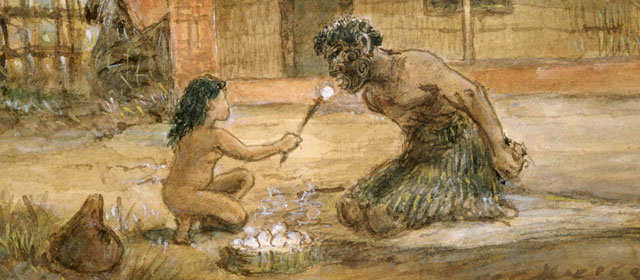Story summary
Ngā atua
In Māori tradition, creation began with the atua (gods). First came Te Kore (the void), then Te Pō (the night) and then Te Ao Mārama (the world of light).
The children of Papatūānuku (earth mother) and Ranginui (sky father) included Tāne, god of forests, Tangaroa, god of the sea, Rongo, god of cultivated food, and Tūmatauenga, god of war.
Tāne made the first woman, Hineahuone, and married her. Human beings are descended from this union.
Tohunga
Tohunga were either priests or experts in a certain field, for example tohunga whakairo were expert carvers.
Atua and spirits could communicate through a tohunga, who would speak in a different voice.
Tohunga ensured people carried out the correct rituals when they gathered food or went to war.
Matakite were people who could see into the future, or could see events happening elsewhere. Many tohunga were also matakite.
Spiritual ideas
People had power called mana which came from the ancestors. First-born children and tohunga had greater mana than others.
Living things and objects could be affected by tapu. There were ceremonies to remove tapu so they were noa (ordinary, free from restrictions).
A person’s spirit was known as wairua. Wairua could leave the body and go wandering.
Karakia
Tohunga communicated with the atua using karakia. There were many different types of karakia, including simple children’s karakia.
Rituals
When babies were born they were dedicated to a god at a ceremony called tohi. It was one of several rituals performed after childbirth.
Sometimes a tohunga or chief would make a place or thing tapu, so people’s behaviour was restricted. This was called a rāhui.
When people went fishing, they threw their first catch back to Tangaroa. The first bird caught was offered to Tāne, and the first kūmara to Rongo.
Tūāhu and wāhi tapu
Shrines made of stones were built away from villages. These tūāhu were tapu. Other places, for example burial grounds, were also wāhi tapu (tapu places). The latrine (toilet) was also tapu.





